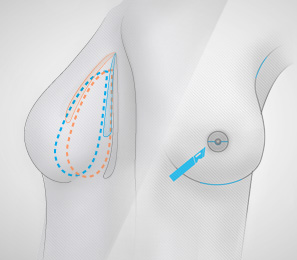Breast augmentation

Why?
the intervention is performed on women who would like to have more volume or on women whose breasts have become less firm or less generous following a pregnancy or a loss of weight.
Mammary augmentation can be combined with a correction of the areola or the nipple.

The Intervention
The operation is performed under general anaesthesia and takes about an hour. It consists of inserting a prosthesis of which the size, filling, form and positioning (beneath the glandular tissue or behind the pectoral muscle) are chosen by the patient, in consultation with the surgeon. Mammary implants can be inserted in three different ways: via the areola, via the fold of the breast or via an incision in the armpit.

Results and Post-Operative Treatment
The patient can return home on the day of the operation.
After the intervention, a waterproof dressing is applied and a specific bra has to be worn. The first four days can be relatively painful, especially in the event of submuscular positioning.
The result can be seen one month after the intervention but six months are needed for appreciating the final result.
Know more aout it
- A mammary augmentation is an aesthetic operation, which alters the size and the form of the breasts.
- It is therefore a question of a very personal decision and intervention.
- The patient’s expectations, needs and desires must be clearly discussed with the surgeon, in order to determine how they can be met as effectively as possible in the light of the many different shapes and sizes of the available implants.
- It is also important to discuss the advantages and the risks of each option beforehand (guarantee, formation of cocci, etc).
The Prosthesis and its Filling
- The implants are made of medical-grade silicone.
- There are other fillings on the market (liquid silicone gel, saline solution, solution containing sugar or other organic matters, and so on).
- In order to meet its patients’ requests as precisely as possible, Beclinic, for solid silicone gel implants, has several brands at its disposal. Each of them offers particular characteristics, which enables the implant to be chosen according to the patient’s physiognomy and the desired result.
- When someone would like to have an implant of a particular brand which is not on the above list, that particular implant can be ordered.
Risk of Cocci Formation
- The insertion of mammary implants enables natural breasts to be imitated to perfection. But the organism, on really rare occasions, can react to the insertion of a foreign body. The mammary prostheses then cause the formation of a coccus i.e. of a layer of conjunctive tissue around the mammary implant.
- In certain cases, this coccus can unfortunately thicken and contract, but this phenomenon is not entirely explainable. It represents no medical danger in itself, but the breasts become exceptionally round and hard. There can also be a risk of that a lime deposit will be formed. Should a coccus be formed, the patient would be able to have it removed without impairing the aesthetic result.
- The mammary prostheses that present the lowest risk of coccus formation are the micro-textured ones that are filled with cohesive gel. It is particularly for this reason that this is the type of mammary implant that Beclinic prefers.
Shape
The mammary implant can be round or anatomical (= drop-shaped).
Round Mammary Prosthesis
This shape rather fills the upper part of the breast. When the woman is standing up, it becomes drop-shaped; this effect can be accentuated if the prosthesis is positioned behind the muscle.
Anatomical or Drop-Shaped Mammary Prosthesis
Thanks to this shape, the upper part of the breast is naturally filled. It therefore provides a little less projection in the upper part of the breast, which can produce a more natural result, especially in the case of a more significant mammary augmentation. Its insertion however requires a larger incision.
Size
Apart from the filling and the shape of the mammary implant, the size of the prosthesis has to be chosen. The most natural result is obtained when the breasts form a balanced whole with the body. The size of the cup and the relationship with the patient’s morphology are also factors that have to be taken into account.
Positioning
The implant can be placed under the glandular tissue or behind the pectoral muscle.
Under the Glandular Tissue (Subglandular)
The implant can be positioned under the glandular tissue, which gives a good result if there is enough tissue prior to the intervention. If this is not the case, indeed, there is a risk that the upper edge of the prosthesis would be visible.
Behind the Pectoral Muscle (Submuscular or Dual Plane)
When the mammary implant is placed behind the pectoral muscle, it is covered with an additional layer of muscle. The risk of the edge of the prosthesis being visible is therefore reduced. The layer of muscle rests on the upper part of the mammary implant: the round prosthesis will then become drop-shaped. The risk of coccus formation is reduced in the case of submuscular positioning.
Incision
Mammary implants can be inserted in three different ways: via the areola, via the fold of the breast or via an incision in the armpit. Each place has its own pros and cons.
Via the Areola
The incision is made via the areola and leaves a barely visible scar. The size of the incision is determined by the size of the areola. It entails a slightly greater risk of infection than the other techniques.
Via the Fold of the Breast
This is the most practised technique; implants of every kind can be placed via this incision. The scar is barely visible since it is in the fold under the breast. In the event of new intervention, following a coccus formation, for example, this kind of incision would be preferred.
Via an Incision in the Armpit
A breast enlargement can also be performed via the armpit, but the mammary prostheses can then tend to move upwards. On the other hand, as the scar is not on the breast, it is not seen.